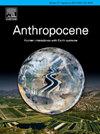The effects of seaweed and shellfish mariculture on the fecal carbon flux of zooplankton in a mariculture base of southern China: Implications for the biological pump
IF 3.9
2区 地球科学
Q2 ENVIRONMENTAL SCIENCES
引用次数: 0
Abstract
Zooplankton play a pivotal role in the marine ecosystem, with their fecal pellets constituting the primary component of passively sinking particles in the ocean. The sinking of fecal pellets provides an effective vector for the transfer and sequestration of particulate organic carbon in the sea. Mariculture activities are extensively practiced along the coastline of China. We hypothesized that seaweed and shellfish mariculture would differentially affect zooplankton community structure and fecal carbon flux due to differences in habitat provision and food source. Aimed to test this hypothesis, surveys were carried out in different mariculture areas around Nan'ao Island in the South China Sea from March to June 2023 during seaweed Gracilaris lemaneiformis cultivation. A total of 36 zooplankton species were identified, including 27 copepod species. Zooplankton abundance ranged from 500 to 2760 ind. m−3, with the highest abundance observed in the G.lemaneiformis cultivation area (P < 0.05). Furthermore, the Shannon-Wiener diversity index of the zooplankton community in the G.lemaneiformis area surpassed that of the shellfish and control areas (P < 0.05). The abundance of zooplankton fecal pellets fluctuated between 12 and 283 pellets m−3, and the fecal pellet carbon flux ranged from 0.004 to 0.976 mg C m−2 d−1. The fecal pellet abundance and carbon flux of zooplankton peaked in the G.lemaneiformis cultivation area (P < 0.05). Results showed mariculture activities affect zooplankton community structure and their fecal pellet carbon flux; the large-scale cultivation of G.lemaneiformis enhances zooplankton diversity and effectively increases the carbon flux of fecal pellets in the coastal waters. These findings could provide new management strategies for mariculture environments with increasing anthropogenic stressors in the Anthropocene Epoch.
海藻和贝类养殖对华南海水养殖基地浮游动物粪便碳通量的影响:对生物泵的启示
浮游动物在海洋生态系统中起着举足轻重的作用,它们的粪便颗粒是海洋被动下沉颗粒的主要组成部分。粪便颗粒的沉降为海洋中颗粒有机碳的转移和固存提供了有效载体。中国沿海地区广泛从事海水养殖活动。我们假设海藻和贝类养殖对浮游动物群落结构和粪便碳通量的影响是不同的,这是由于栖息地条件和食物来源的不同。为了验证这一假设,我们于2023年3月至6月在南海南澳岛周围不同的海水养殖区进行了调查。共鉴定出浮游动物36种,其中桡足类27种。浮游动物丰度在500 ~ 2760 ind. m - 3之间,其中以羊草养殖区丰度最高(P <; 0.05)。此外,lemaneiformis区浮游动物群落的Shannon-Wiener多样性指数超过贝类和对照区(P <; 0.05)。浮游动物粪球丰度在12 ~ 283粒m−3之间波动,碳通量在0.004 ~ 0.976 mg C m−2 d−1之间波动。浮游动物粪便颗粒丰度和碳通量在羊草养殖区最高(P <; 0.05)。结果表明:海水养殖活动影响浮游动物群落结构及其粪球碳通量;大规模养殖lemaneiformis增加了浮游动物的多样性,有效增加了沿海水域粪便颗粒的碳通量。这些发现可以为人类世时期日益增加的人为压力的海水养殖环境提供新的管理策略。
本文章由计算机程序翻译,如有差异,请以英文原文为准。
求助全文
约1分钟内获得全文
求助全文
来源期刊

Anthropocene
Earth and Planetary Sciences-Earth and Planetary Sciences (miscellaneous)
CiteScore
6.30
自引率
0.00%
发文量
27
审稿时长
102 days
期刊介绍:
Anthropocene is an interdisciplinary journal that publishes peer-reviewed works addressing the nature, scale, and extent of interactions that people have with Earth processes and systems. The scope of the journal includes the significance of human activities in altering Earth’s landscapes, oceans, the atmosphere, cryosphere, and ecosystems over a range of time and space scales - from global phenomena over geologic eras to single isolated events - including the linkages, couplings, and feedbacks among physical, chemical, and biological components of Earth systems. The journal also addresses how such alterations can have profound effects on, and implications for, human society. As the scale and pace of human interactions with Earth systems have intensified in recent decades, understanding human-induced alterations in the past and present is critical to our ability to anticipate, mitigate, and adapt to changes in the future. The journal aims to provide a venue to focus research findings, discussions, and debates toward advancing predictive understanding of human interactions with Earth systems - one of the grand challenges of our time.
 求助内容:
求助内容: 应助结果提醒方式:
应助结果提醒方式:


